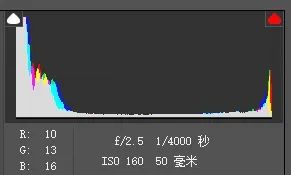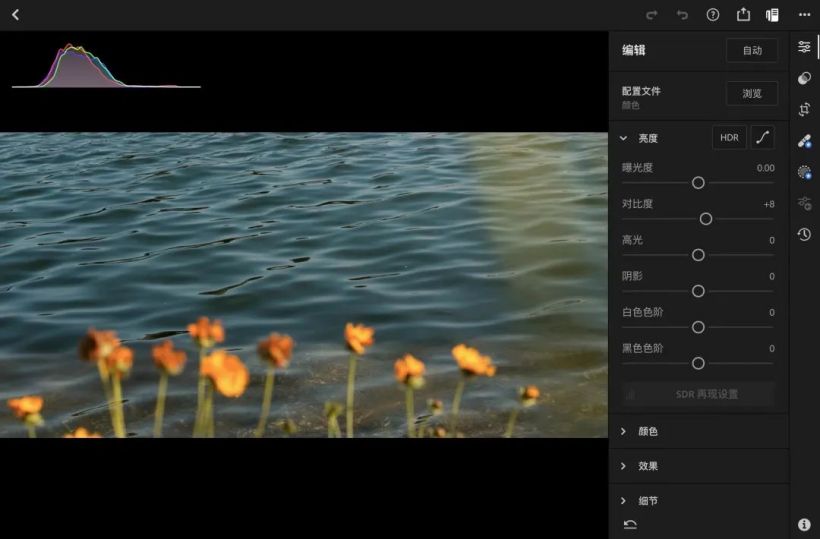Why do you need to know histograms to learn photography?
Many people encounter this situation when taking daily photos:
The photos on the camera seem to be exposed normally, but after exporting the photos, they find that their true form is far from the camera's rendering, and there is obviously a problem with the exposure.

Affected by environmental light, screen brightness and other factors, this situation is relatively normal, but it also brings us a revelation: when looking at photos and analyzing photos, you must learn to read the histogram Picture .
So, what is a histogram?
To simply understand, the histogram is a display form of the brightness distribution of photo pixels:

Horizontally, the histogram can be roughly divided into 3 parts, the left side is the shadow area, and the middle is the midtones part, the right side is the highlight area; the far left is the dead black area in the shadows, and the far right is the overflow area in the highlight.
The vertical axis represents the specific distribution of pixels. For example, if the "hills" on the histogram are concentrated on the left, it means that a large number of pixels in the photo are concentrated in the shadow area, and the overall picture is dark, and there may be underexposure; if the "hills" are If it is concentrated on the right side, it means that the photo is overall bright and may be overexposed.
Thus, when we view the photo, we can call up the histogram on the camera, and more accurately determine whether the photo is properly exposed based on the pixel distribution on the histogram.

Of course, there are different standards for normal exposure according to different themes and creativity, and the histogram only provides us with a reference.
However, we can pay special attention to the dead black and highlight overflow parts, which are the far left and right sides of the histogram. If there are a large number of pixels distributed in this part, then the photo is likely to be obviously underexposed or overexposed. , we need to adjust the shooting in time.

In addition to reflecting the exposure, the histogram can also give us a reference for the light and dark contrast of the photo:
We still regard the histogram as three parts: shadow, midtones, and highlights. If the pixels are in the three Each part is distributed:

Then it means that there are three forms of shadow, mid-tone and highlight in the photo at the same time, and the whole has a certain contrast, just like the photo below:

And if the pixels are mainly concentrated in the shadow and highlight areas:

, it means that the contrast of the photo is very high, and the contrast between light and dark is great, just like the following effect:

On the contrary, if the span of pixels in the photo is very small and only concentrated in a certain area, it means that the contrast between light and dark in the photo is very small and the pixel distribution is very even:


It can be seen from here that the histogram can bring great convenience and reference to us in the later stage. When we adjust some parameters, the histogram also changes accordingly.
For example, when we increase the contrast, the light and dark contrast of the photo is enhanced, and the pixels on the histogram will move closer to both sides; when we increase the shadows, the pixels on the left side of the histogram will move closer to the right; and when we increase the exposure, All pixels on the histogram will move to the right as a whole.
Based on this property of the histogram, we can easily analyze the light and shadow characteristics of a photo.
When we encounter a photo we like, we can first call up its histogram, and then imitate its light and shadow effects based on the reference of the histogram. This way we don’t have to worry about parameters and filters, because the “understanding” of the photo has already been Completely exposed by a small histogram.

色彩方面也是如此,一些後期工具如 Lightroom,不僅可以顯示光影直方圖,還可以以三原色的形式反映色彩特徵,其原理與光影是一樣的。
由此可以看出,只要會看直方圖,我們幾乎能複製模擬出大多數照片的風格,我們對拍攝、後期的理解也會有質的突破。
今天的內容就到這裡了~
The above is the detailed content of Why do you need to know histograms to learn photography?. For more information, please follow other related articles on the PHP Chinese website!

Hot AI Tools

Undresser.AI Undress
AI-powered app for creating realistic nude photos

AI Clothes Remover
Online AI tool for removing clothes from photos.

Undress AI Tool
Undress images for free

Clothoff.io
AI clothes remover

AI Hentai Generator
Generate AI Hentai for free.

Hot Article

Hot Tools

Notepad++7.3.1
Easy-to-use and free code editor

SublimeText3 Chinese version
Chinese version, very easy to use

Zend Studio 13.0.1
Powerful PHP integrated development environment

Dreamweaver CS6
Visual web development tools

SublimeText3 Mac version
God-level code editing software (SublimeText3)

Hot Topics
 1378
1378
 52
52
 Tutorial on how to use Dewu
Mar 21, 2024 pm 01:40 PM
Tutorial on how to use Dewu
Mar 21, 2024 pm 01:40 PM
Dewu APP is currently a very popular brand shopping software, but most users do not know how to use the functions in Dewu APP. The most detailed usage tutorial guide is compiled below. Next is the Dewuduo that the editor brings to users. A summary of function usage tutorials. Interested users can come and take a look! Tutorial on how to use Dewu [2024-03-20] How to use Dewu installment purchase [2024-03-20] How to obtain Dewu coupons [2024-03-20] How to find Dewu manual customer service [2024-03-20] How to check the pickup code of Dewu [2024-03-20] Where to find Dewu purchase [2024-03-20] How to open Dewu VIP [2024-03-20] How to apply for return or exchange of Dewu
 Quark browser usage tutorial
Feb 24, 2024 pm 04:10 PM
Quark browser usage tutorial
Feb 24, 2024 pm 04:10 PM
Quark Browser is a very popular multi-functional browser at the moment, but most friends don’t know how to use the functions in Quark Browser. The most commonly used functions and techniques will be sorted out below. Next, the editor will guide users. Here is a summary of the multi-functional usage tutorials of Quark Browser. Interested users can come and take a look together! Tutorial on how to use Quark Browser [2024-01-09]: How to scan test papers to see answers on Quark [2024-01-09]: How to enable adult mode on Quark Browser [2024-01-09]: How to delete used space on Quark [2024 -01-09]: How to clean up the Quark network disk storage space [2024-01-09]: How to cancel the backup of Quark [2024-01-09]: Quark
 Upgrading numpy versions: a detailed and easy-to-follow guide
Feb 25, 2024 pm 11:39 PM
Upgrading numpy versions: a detailed and easy-to-follow guide
Feb 25, 2024 pm 11:39 PM
How to upgrade numpy version: Easy-to-follow tutorial, requires concrete code examples Introduction: NumPy is an important Python library used for scientific computing. It provides a powerful multidimensional array object and a series of related functions that can be used to perform efficient numerical operations. As new versions are released, newer features and bug fixes are constantly available to us. This article will describe how to upgrade your installed NumPy library to get the latest features and resolve known issues. Step 1: Check the current NumPy version at the beginning
 In summer, you must try shooting a rainbow
Jul 21, 2024 pm 05:16 PM
In summer, you must try shooting a rainbow
Jul 21, 2024 pm 05:16 PM
After rain in summer, you can often see a beautiful and magical special weather scene - rainbow. This is also a rare scene that can be encountered in photography, and it is very photogenic. There are several conditions for a rainbow to appear: first, there are enough water droplets in the air, and second, the sun shines at a low angle. Therefore, it is easiest to see a rainbow in the afternoon after the rain has cleared up. However, the formation of a rainbow is greatly affected by weather, light and other conditions, so it generally only lasts for a short period of time, and the best viewing and shooting time is even shorter. So when you encounter a rainbow, how can you properly record it and photograph it with quality? 1. Look for rainbows. In addition to the conditions mentioned above, rainbows usually appear in the direction of sunlight, that is, if the sun shines from west to east, rainbows are more likely to appear in the east.
 Tutorial on how to turn off the payment sound on WeChat
Mar 26, 2024 am 08:30 AM
Tutorial on how to turn off the payment sound on WeChat
Mar 26, 2024 am 08:30 AM
1. First open WeChat. 2. Click [+] in the upper right corner. 3. Click the QR code to collect payment. 4. Click the three small dots in the upper right corner. 5. Click to close the voice reminder for payment arrival.
 DisplayX (monitor testing software) tutorial
Mar 04, 2024 pm 04:00 PM
DisplayX (monitor testing software) tutorial
Mar 04, 2024 pm 04:00 PM
Testing a monitor when buying it is an essential part to avoid buying a damaged one. Today I will teach you how to use software to test the monitor. Method step 1. First, search and download the DisplayX software on this website, install it and open it, and you will see many detection methods provided to users. 2. The user clicks on the regular complete test. The first step is to test the brightness of the display. The user adjusts the display so that the boxes can be seen clearly. 3. Then click the mouse to enter the next link. If the monitor can distinguish each black and white area, it means the monitor is still good. 4. Click the left mouse button again, and you will see the grayscale test of the monitor. The smoother the color transition, the better the monitor. 5. In addition, in the displayx software we
 What software is photoshopcs5? -photoshopcs5 usage tutorial
Mar 19, 2024 am 09:04 AM
What software is photoshopcs5? -photoshopcs5 usage tutorial
Mar 19, 2024 am 09:04 AM
PhotoshopCS is the abbreviation of Photoshop Creative Suite. It is a software produced by Adobe and is widely used in graphic design and image processing. As a novice learning PS, let me explain to you today what software photoshopcs5 is and how to use photoshopcs5. 1. What software is photoshop cs5? Adobe Photoshop CS5 Extended is ideal for professionals in film, video and multimedia fields, graphic and web designers who use 3D and animation, and professionals in engineering and scientific fields. Render a 3D image and merge it into a 2D composite image. Edit videos easily
 Experts teach you! The Correct Way to Cut Long Pictures on Huawei Mobile Phones
Mar 22, 2024 pm 12:21 PM
Experts teach you! The Correct Way to Cut Long Pictures on Huawei Mobile Phones
Mar 22, 2024 pm 12:21 PM
With the continuous development of smart phones, the functions of mobile phones have become more and more powerful, among which the function of taking long pictures has become one of the important functions used by many users in daily life. Long screenshots can help users save a long web page, conversation record or picture at one time for easy viewing and sharing. Among many mobile phone brands, Huawei mobile phones are also one of the brands highly respected by users, and their function of cropping long pictures is also highly praised. This article will introduce you to the correct method of taking long pictures on Huawei mobile phones, as well as some expert tips to help you make better use of Huawei mobile phones.





